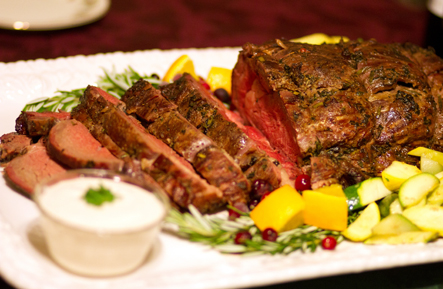 The traditional preparation for a standing rib roast, aka Prime Rib, is to rub the outside of the roast with salt and seasonings then slow-roast with dry heat. Prime Rib can make a truly memorable meal and for special occasions like Christmas dinner I like to add some herbs and a few more spicy for a flavorful crust.
The traditional preparation for a standing rib roast, aka Prime Rib, is to rub the outside of the roast with salt and seasonings then slow-roast with dry heat. Prime Rib can make a truly memorable meal and for special occasions like Christmas dinner I like to add some herbs and a few more spicy for a flavorful crust.
Prime Rib is a great cut of meat. Expensive, but the quality of the meat does all of the hard work for you. There are just a few tips that I’d like to share with you to make it a foolproof dish.
Remember how we brined our Smoked Turkey for Thanksgiving Dinner last month? It was tender, moist and had such a great flavor! Well, we’re going to do a similar thing here. Below I’ll show you how to dry brine this wonderful cut of beef – this will pull in some flavor into the meat.
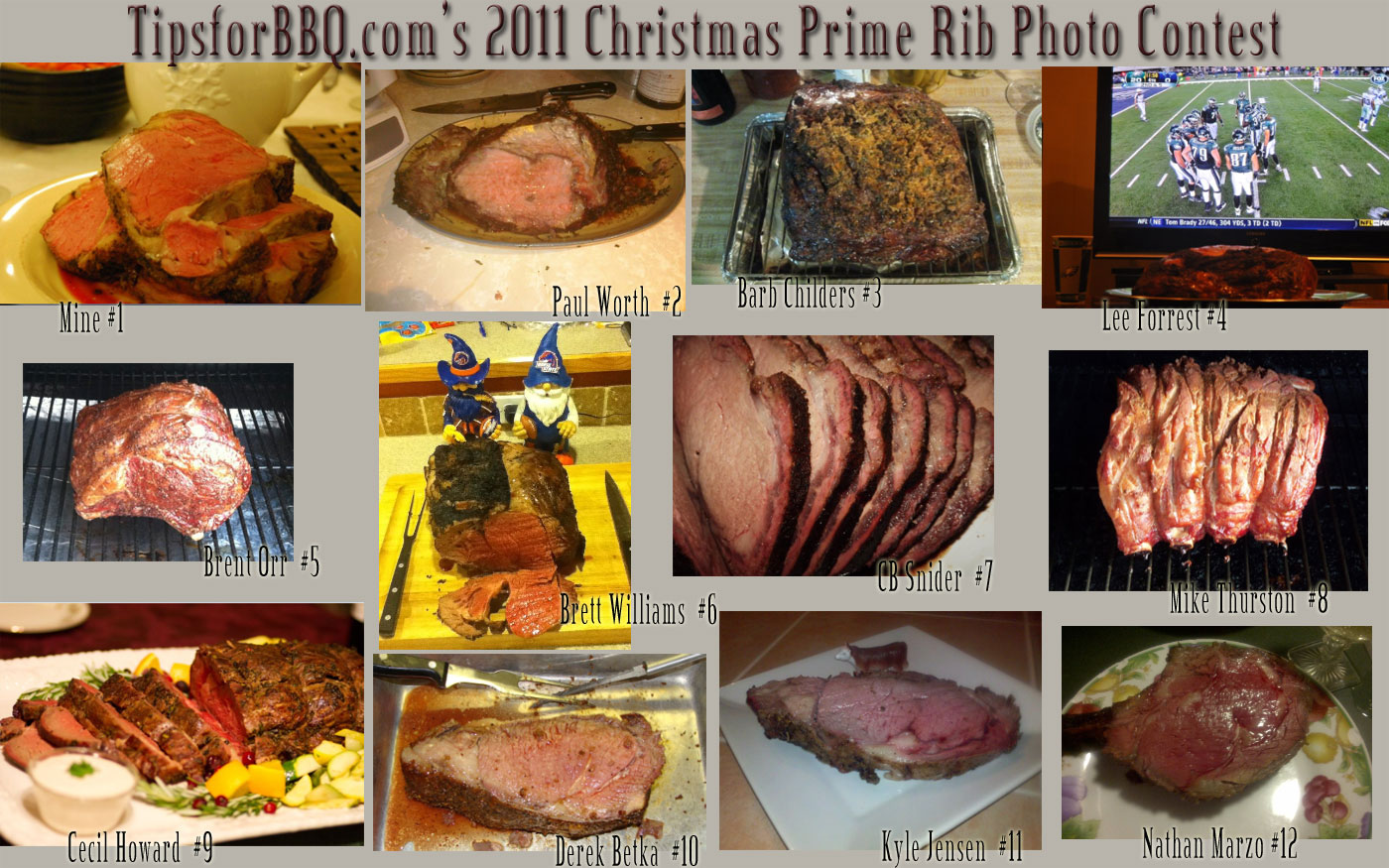 We had a lot of fun with the 2011 Christmas Prime Rib Photo Contest. Here is a picture of all the submissions (click it to enlarge). They all looked great, but we put it up for a vote and Cecil with #9 won the prize of an Amazon gift card with the above photo.
We had a lot of fun with the 2011 Christmas Prime Rib Photo Contest. Here is a picture of all the submissions (click it to enlarge). They all looked great, but we put it up for a vote and Cecil with #9 won the prize of an Amazon gift card with the above photo.
Join the fun and be sure to enter your own prize winning photo in our next contest - just friend me on facebook to know about the next contest!
What is Prime Rib
Now, not every cut of Prime Rib is actually USDA Prime Grade beef. In fact, chances are most cuts you will see at your local grocers will probably be choice – but that’s okay. They’ll still make a killer dinner. The name "prime rib" pre-dates the beef grading scale and it’s what you’ll see it called on the menu of your favorite steakhouse. When you do go to buy you’ll want to either ask your butcher for "top choice", which is a well-marbled choice grade, or hunt down a source for USDA prime grade "prime rib".
What to Buy
The prime rib, or rib roast, is sold two ways: bone-in or boneless. Either is fine – although given the choice I prefer bone-in (save them to make beef ribs. If it is bone-in ask the butcher to cut off the chine bones from the bottom and separate the rib bones from the meat. Have them placed back on and wrapped up. Most butchers will already have this done and have them tied together since this is a common request. This not only makes it easier to carve, but you can season all sides of the meat rather than the backside of the ribs.
As for selecting the right roast, what you want to look for is a creamy, white colored fat cap on top. The meat should also be a uniform bright red color with small striations of fat or marbling.
This prime rib recipe is geared toward a 4-bone roast which is usually enough for 6-7 people with some leftovers. Plan on the roast feeding two people per rib. A whole stand rib roast, or prime rib roast, consists of the ribs numbered 6 through 12 (7 ribs/14 people). If you won’t be cooking a whole roast you should also know that since this is a large cut of meat there is actually a noticeable difference from end to end. The "small end" or "first cut" is a roast cut from ribs #10-12. This section is closest to the beef short loin and is more tender. Then "center cut" roast from ribs #6-8 will have a little more flavor since it is a little fattier and close to the beef shoulder. But frankly, it’s hard to go wrong with either one!
Dry Brining (24-36 hours)
Dry Brining
Dry brining is a technique popularized by Chef Judy Rodgers of San Francisco's Zuni Cafe.
It sounds counter-intuitive; for years the commonly accepted wisdom was that pre-salting dries out meat. But a moderate salting here will do just the opposite.
How does it work?
1) For steaks and pork chops take the meat out of the fridge about an hour before cooking.
2) Pat it dry with a paper towel. Sprinkle salt on the meat, about the same amount you would use at the table or a little more, and massage it in.
3) The salt draws out moisture which dissolves the salt.
4) The meat reabsorbs the moisture and brings the salt in with it.
Note: For larger cuts of meat, like birds and roasts, use 2 teaspoons for every 5 lbs of meat. Sprinkle it over the surface and rub it in. Refrigerate for 24-36 hours.
1) Trim any thick pieces of fat from the roast.
2) Un-wrap the roast and reserve the ribs.
3) Thoroughly rub the salt and garlic all over the roast.
4) Break up the fresh rosemary into smaller pieces and cover evenly. This will pull in a slight flavor of the herbs into the meat.
5) Re-wrap the roast and let it sit in the fridge for 24-36 hours.
Note: only use 2 tsp of kosher salt per 4-5 lbs of meat.
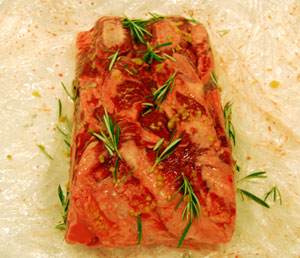 Dry brining is a great trick I use when doing thick-cut, steakhouse steaks which can be done at room temperature while the smoker is warming up. For larger cuts this process takes longer. So in the fridge it goes for 24-36 hours.
Dry brining is a great trick I use when doing thick-cut, steakhouse steaks which can be done at room temperature while the smoker is warming up. For larger cuts this process takes longer. So in the fridge it goes for 24-36 hours.
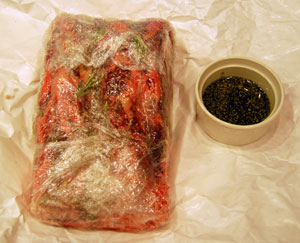 1-2 hours before cooking you should pull the roast out of the fridge. It’s important to allow the roast to come to room temperature before it goes on the grill. This will mean less smoke ring, but it will cook far more evenly. Which is more important?
1-2 hours before cooking you should pull the roast out of the fridge. It’s important to allow the roast to come to room temperature before it goes on the grill. This will mean less smoke ring, but it will cook far more evenly. Which is more important?
Final Prep
Another tip to help the prime rib cook evenly is to use butchers twine to tie it up. Tie it about every 1-2 inches. Try to make the roast as round of a shape as possible.
Now is also a good time to start warming up your smoker and making your wet rub.
For the wet rub, evenly chop the rosemary, oregano and bay leaves. I use a small spice grinder that works well. Mix all the ingredients together in the olive oil. This will make a sort of paste. Allow this to sit for 30-60 minutes before applying. This will allow the dried spices to liven up and bring out their flavor.
that works well. Mix all the ingredients together in the olive oil. This will make a sort of paste. Allow this to sit for 30-60 minutes before applying. This will allow the dried spices to liven up and bring out their flavor.
Apply the wet rub evenly to all sides of the prime rib roast.
Prepare your smoker/grill for indirect cooking. If using wood chunks, you’ll want 2-3 medium sized pieces. For chips you’ll use about 2-3 cups. With a gas grill you can use a smoker pouch to effectively add in that smoky flavor. Good flavors of wood to use for smoke would be any fruitwood such as apple or cherry or a light nut wood like pecan. I’d recommend a mix of apple or pecan and a little mesquite (but go easy).
In a water pan smoker you will want to use an empty water pan to catch the drippings for making beef au jus. For other smoker this can be done with a disposable aluminum pan . Just don’t let the beef sit in the pan – you don’t want to braise the meat.
. Just don’t let the beef sit in the pan – you don’t want to braise the meat.
Cook at 225-250°F for approximately 20-30 minutes per pound. Place the thermometer in the middle of the meat for an accurate temperature. I prefer a wireless thermometer here to closely monitor the temperature from inside.
here to closely monitor the temperature from inside.
Reverse-Searing
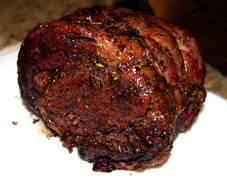 Reverse-Searing is a practice that I first picked up from a video that a friend, Craig Goldwin, put out a year or two ago.
Reverse-Searing is a practice that I first picked up from a video that a friend, Craig Goldwin, put out a year or two ago.
Searing closes the pores of the meat and supposedly "locks in the juices". While this may be true in a slow cooker, this practices doesn’t hold up in most cases and will actually dry out your meat. The meat will tense up and force the juices to the outside when you sear. This actually causes you to lose some of the juices when you do this.
By cooking your meat low and slow you’re steaks/roast will keep most of their juices and benefit from the smoky flavor. Then when you sear it the out crust will brown and caramelize which enhances the savory flavor of your beef. This will impart the complex nutty flavors that steak-lovers crave.
Reverse-Searing
This next step will require familiarity with your grill/smoker, a little practice and a quality thermometer is an absolute must. We’re going to use a method referred to as "reverse-searing" – it’s the practice of smoking first and then searing at the end of the cook. This is the same thing I do on my thick-cut steaks to get the benefits of the smoke and to caramelize the outer crust.
To do this we don’t want to fully cook the prime rib. Bring it to about 10-15°F shy of your final desired temperature. Searing it should take it to the final temperature. For example, for medium-rare I remove mine at about 120°F for an anticipated final temp in the low 130s. We then transfer it to the hottest part of the grill and sear the entire roast. What we're trying to do here is to evenly brown (note: I said brown, not blacken) all sides of the roast. This gives it the final touches of a perfect roast. At this point we're basically done cooking it so live the lid up and keep rotating the roast so all sides get seared.
Note: If you're smoker doesn't go up that high, then you may want to transfer it your grill or when I'm using my pellet smoker (they don’t change temps quickly) I will even pre-heat a cast iron griddle in my oven at 500°F and transfer it to the grill. This is a great way to evenly sear the outside. I have a reader that even uses a griddle on his gas grill to keep flare-ups from ruining the meat. Alternatively, you could transfer it to a pre-heated oven to roast for 5-10 minutes at 450°F.
in my oven at 500°F and transfer it to the grill. This is a great way to evenly sear the outside. I have a reader that even uses a griddle on his gas grill to keep flare-ups from ruining the meat. Alternatively, you could transfer it to a pre-heated oven to roast for 5-10 minutes at 450°F.
The final internal temperatures for beef are as follows:
Rare – 120-130°F
Med-Rare 130-135°F
Medium – 135-145°F
Serving
Transfer it to the cutting board and cover it with foil to let it rest 15-20 minutes before slicing. There shouldn't be more than a few degrees of carry-over temperature. Cut each of ties and cut the roast into half-inch thick slices. Serve with one of the sauces below.
Sauces for Prime Rib
Au Jus
1) Deglaze the drip pan with water or red wine loosening any meat or seasonings.
2) Add a little worcestershire and salt/pepper.
3) Heat for 2-3 minutes
Horseradish Cream Sauce
1 cup sour cream
2 tbsp prepared horseradish
1 tbsp dried green peppercorns, crushed (sweeter)
1 tbsp Worcestershire sauce
Mix all ingredients together and serve chilled.